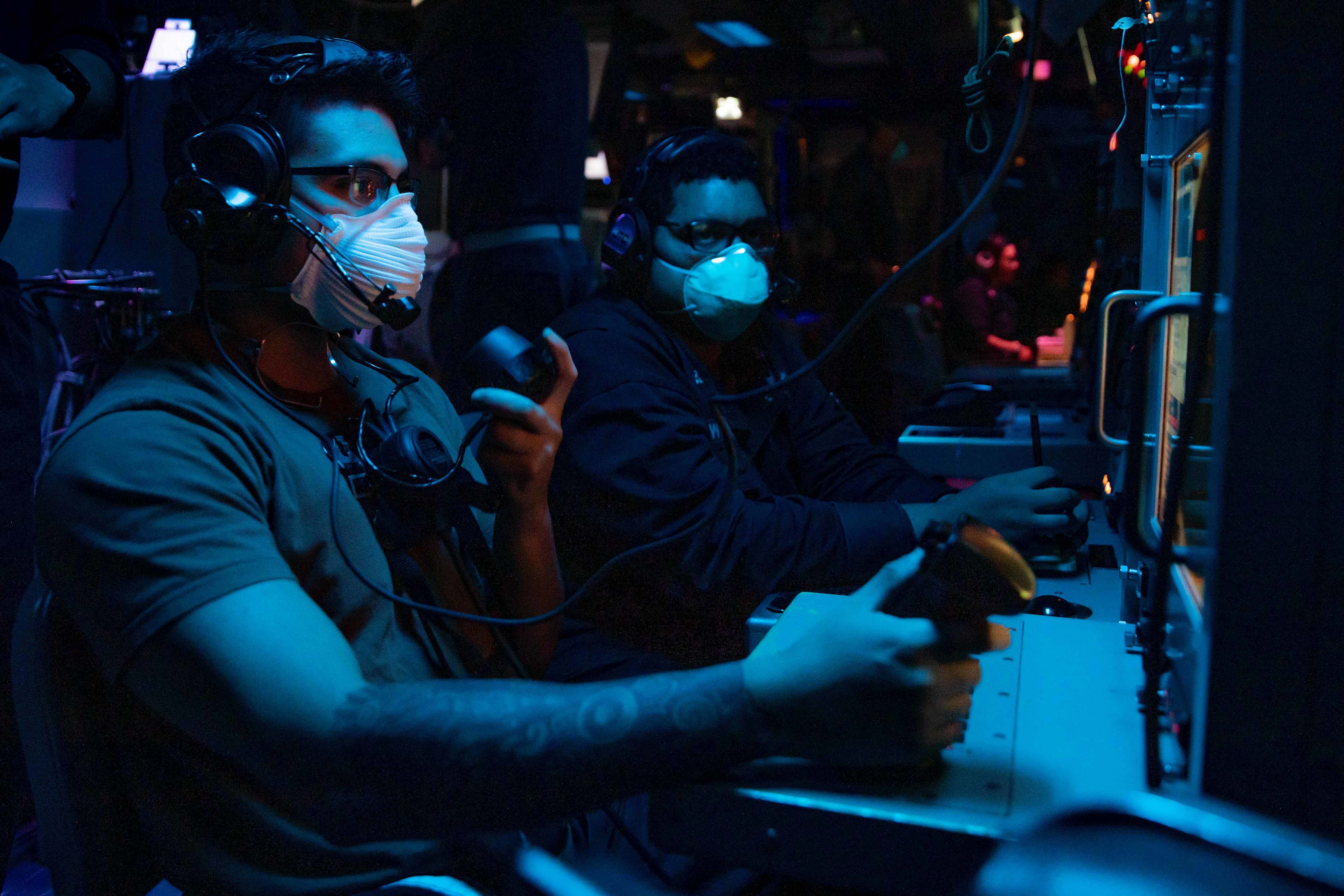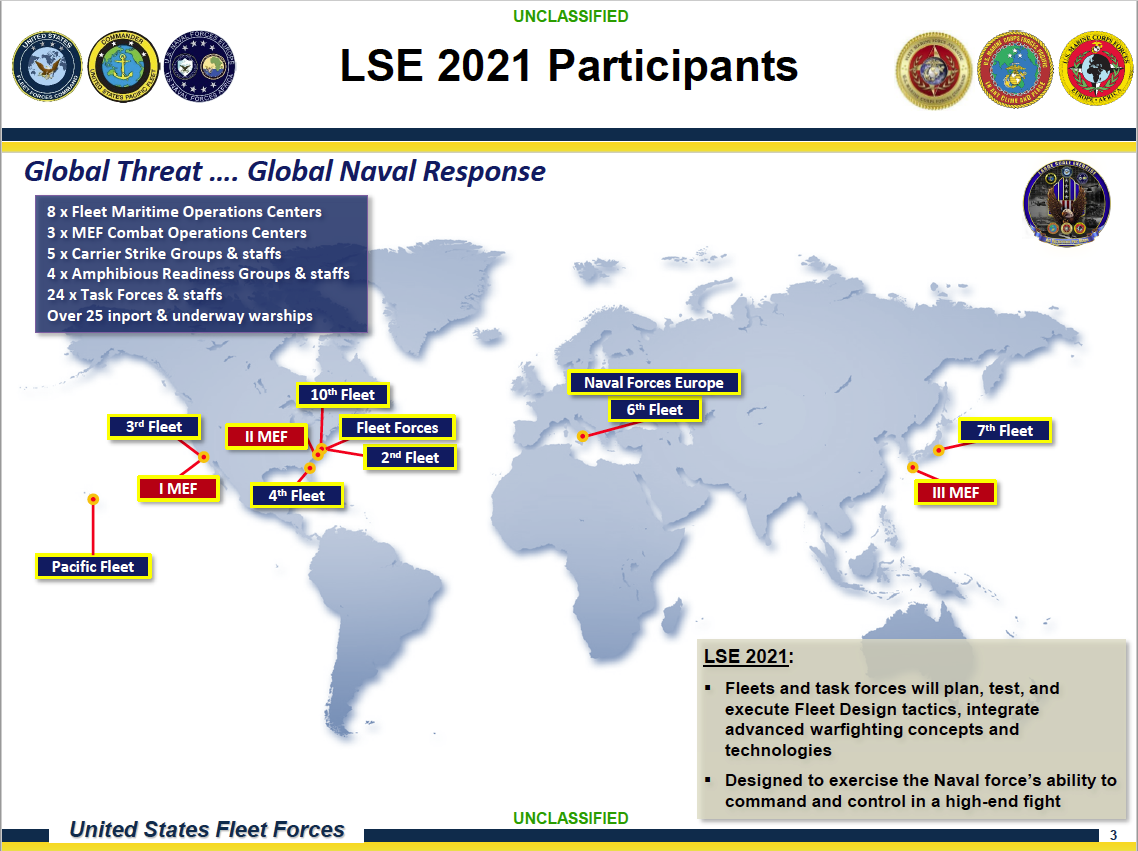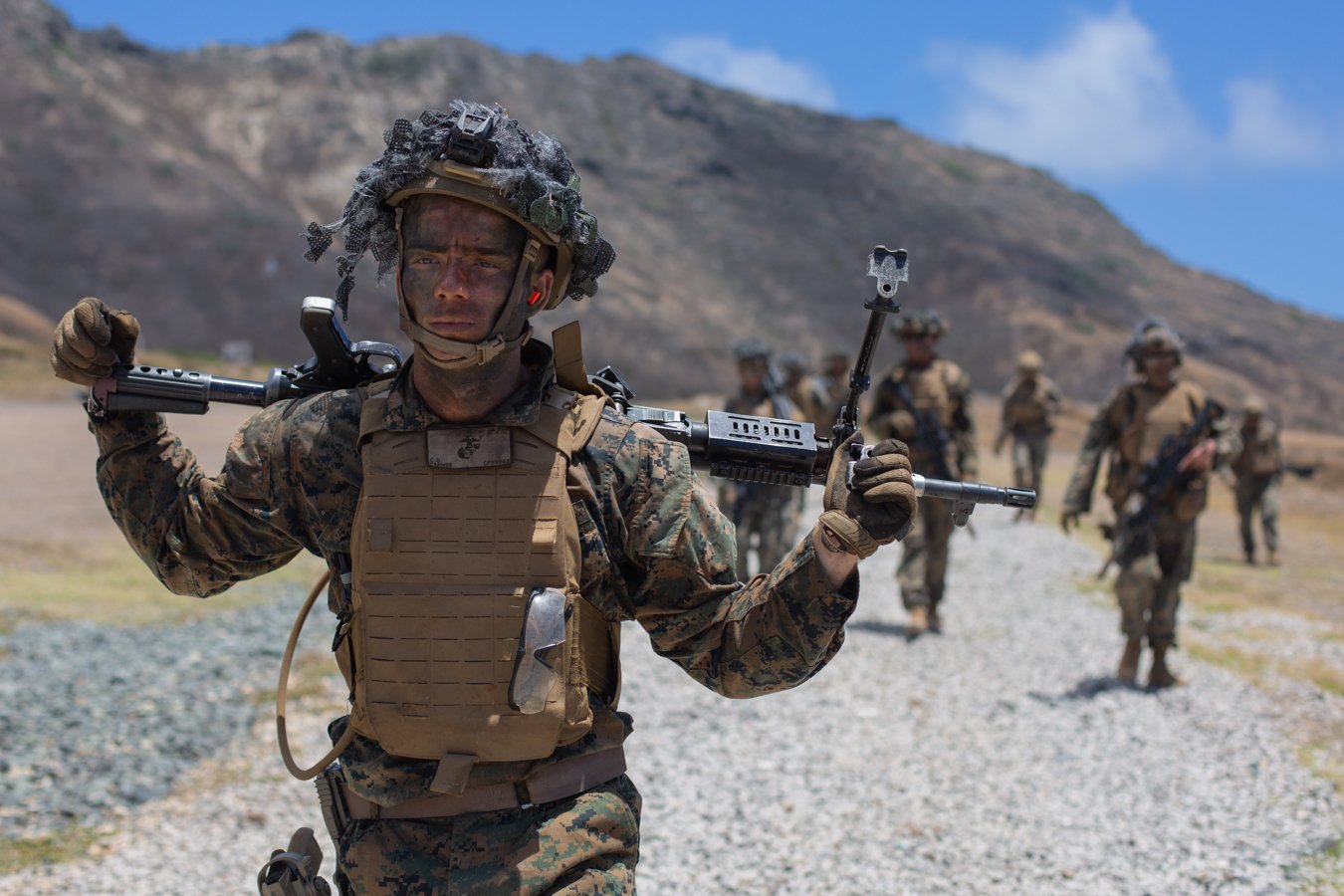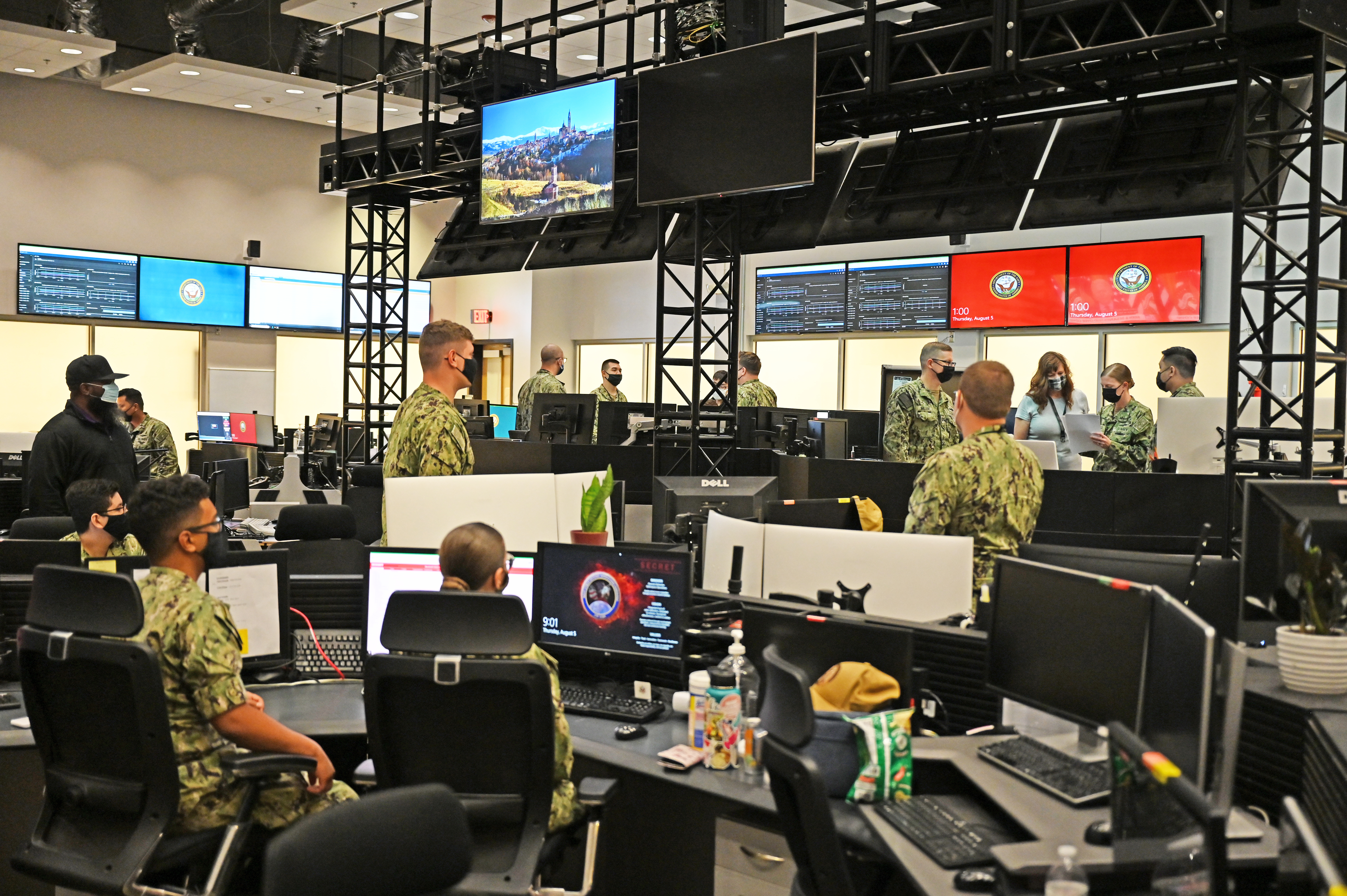
ABOARD GUIDED MISSILE CRUISER USS SAN JACINTO – The Navy and Marine Corps have bet big that they have locked into a workable vision on how they’ll fight in the future, kicking off a massive exercise last week to prove their concepts.
The two-week-long Large Scale Exercise 2021 will put the Navy’s Distributed Maritime Operations, the Marines’ Expeditionary Advanced Base Operations and Littoral Operations in a Contested Environment at a scale that spans 17 time zones, three global combatant commands and more than a dozen command staffs.
LSE was ordered by Chief of Naval Operations Adm. Mike Gilday to test if the shifts in how the Navy and Marines think they want to fight in the future work.
“We want to take a deeper look at DMO, LOCE, EABO and how they tie together. And so that’s important for us conceptually to ensure those concepts in a way we can visualize whether or not we need to course-correct, whether or not we’re headed precisely in the right direction,” CNO Adm. Mike Gilday said in December.
 The Navy has released few details about DMO since the concept began to solidify over the last five years. The basic tenant is to have a fleet commander hold operational control over several major fleet formations like aircraft carrier strike groups, amphibious expeditionary strike groups and surface action groups at the same time, deputy commander of U.S. Fleet Forces Vice Adm. Jim Kilby told reporters last week.
The Navy has released few details about DMO since the concept began to solidify over the last five years. The basic tenant is to have a fleet commander hold operational control over several major fleet formations like aircraft carrier strike groups, amphibious expeditionary strike groups and surface action groups at the same time, deputy commander of U.S. Fleet Forces Vice Adm. Jim Kilby told reporters last week.
“Distributed Maritime Operations is fleet commanders controlling ESGs, CSGs, SAGs, individual units, that’s a little different for us,” Kilby said.
“At a very simple level [DMO] is many units in a distributed fashion, concentrating their fires and their effects.”
The exercise places its major emphasis on the command-and-control structures and the linkages between units and higher commands, exercise planners told reporters at Navy Warfare Development Command at Naval Station Norfolk, Va., which is the center of the exercise.

“It’s unique that we have all the Navy component commanders, the four-star fleet commanders involved, it’s unique that we’re doing something on this scale, as a naval exercise with the Navy and the Marine Corps. It’s more than 25,000 folks that are all linked together, and in the same battle problem all at once,” exercise director Rear Adm. Douglas Beal told reporters last week.
“Everyone of those warfighting concepts that we’ve talked about, the ones with all the alphabet soup … This is an opportunity to exercise those capabilities.”
In addition to the exercise planners, the Navy has tapped a retired panel of flag and general officers to serve as a higher command authority to fit the scale of the exercise – including retired Fleet Forces commander Adm. Bill Gortney acting as the Secretary of Defense, a Navy official told USNI News on Monday.
The scale is less about the number of ships involved – more than 25 in port and underway – and more about coordinating the various command staffs in the Pacific and the Atlantic theaters on working the same problem and reacting to the same input from the tactical level of the exercise.
“It’s one scenario for everybody and it’s being simulated differently,” Ron Keter, an exercise planner, told reporters.
Until now, attempting an exercise at this size that links the tactical decisions of sailors and Marines to four-star fleet commanders has been difficult to simulate. The backbone of LSE is the Navy’s growing live, virtual, constructive (LVC) training regime that creates realistic simulations for ships at sea to augment instrumented training ranges and real-world training scenarios. The commands are linked through the Navy Continuous Training Environment (NCTE), the technology that allows ships and aircraft at sea, ships in port and simulators around the world to play in the same wargame.
For example, sailors making decisions in the combat information center in the belly of a cruiser in Norfolk determine the fate of a simulated carrier strike group off Norway in this massive Large Scale Exercise.
Piggybacking off advances in Navy LVC technology, the LSE scenario links sailors in USS San Jacinto’s (CG-56) CIC doing regular training as part of their pre-deployment cycle to the larger game. For almost a decade, sailors on surface ships have used fleet synthetic training (FST) to simulate training scenarios, like tracking aircraft or missiles without having to fly or fire weapons.
“They were doing exactly what they would be doing. Underway, they’re sitting in the same seats, they’re talking on the same circuits, they’re looking at the same displays,” San Jacinto commander Capt. Christopher Marvin told reporters aboard the cruiser.

Marvin and his crew have exercised with a strike group through FST, but the LSE drastically changes the scale of the exercise.
“Now you’ve brought a whole smorgasbord of other units in play, and the coordination that goes with that,” he said. “Because now it’s not just you fighting the battle. It’s how I have to coordinate with the group next to me, the staff C2 … there’s a huge piece above us.”
For sailors in CIC, the units could be real or simulated, Marvin said.
“There’s live players in the game that are out here, there are virtual players that may be purely computer-generated tracks. And then there’s the in-between where sometimes these F/A-18s I talked about that are being flown, these are men and women in [Naval Air Station] Oceana, and they are in a static simulator. They have much more high-end simulators, as I have seen, but they get in the simulator and they’ll fly the mission virtually, from Oceana. Although it’ll appear that they’re out here, performing the mission, and we talk to them the same way, and we control the same way,” he said.
In the LSE battle problem, San Jacinto is attached to U.S. 6th Fleet in Europe. While SPY-1 radar operator OS2 Matthew Falgoust sees the East Coast on his screen, the exercise has his ship operating off the coast of Norway. Actions that he takes at his console can have effects beyond just his ship or his strike group.
“It’s definitely opened my eyes a little bit more because you’re starting to see things outside the box,” he told reporters in the ship’s CIC last week.
“We’re not just working on the things that are known to work, and actually, we’re learning a lot more from our [tactical action officer], different [sailors] in combat as a whole, to gain more knowledge and to kind of branch out.”





